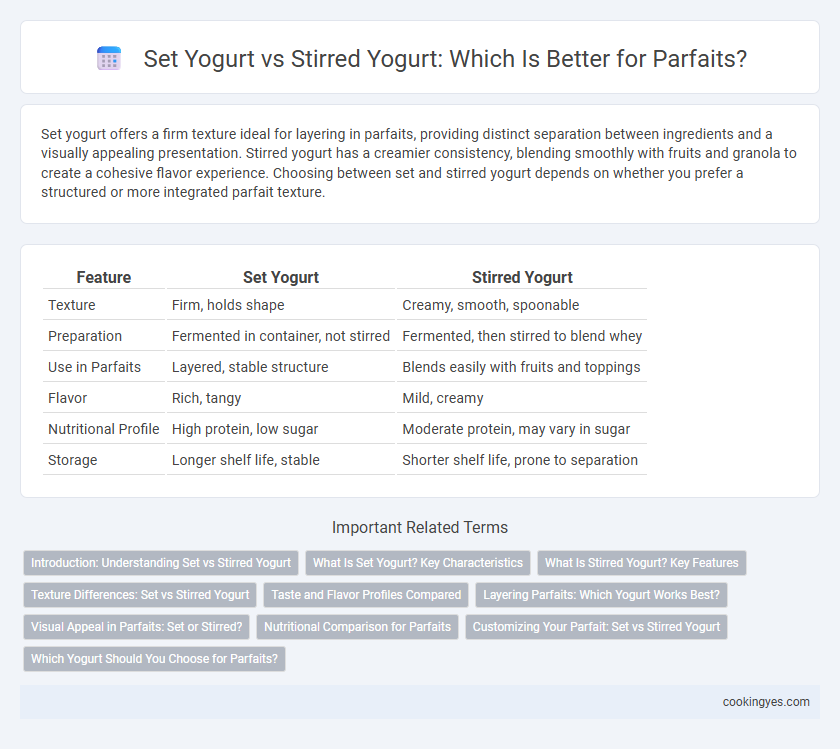Set yogurt offers a firm texture ideal for layering in parfaits, providing distinct separation between ingredients and a visually appealing presentation. Stirred yogurt has a creamier consistency, blending smoothly with fruits and granola to create a cohesive flavor experience. Choosing between set and stirred yogurt depends on whether you prefer a structured or more integrated parfait texture.
Table of Comparison
| Feature | Set Yogurt | Stirred Yogurt |
|---|---|---|
| Texture | Firm, holds shape | Creamy, smooth, spoonable |
| Preparation | Fermented in container, not stirred | Fermented, then stirred to blend whey |
| Use in Parfaits | Layered, stable structure | Blends easily with fruits and toppings |
| Flavor | Rich, tangy | Mild, creamy |
| Nutritional Profile | High protein, low sugar | Moderate protein, may vary in sugar |
| Storage | Longer shelf life, stable | Shorter shelf life, prone to separation |
Introduction: Understanding Set vs Stirred Yogurt
Set yogurt forms a firm, gel-like texture due to fermentation directly in the container, making it ideal for parfaits that require stable layers and a clean presentation. Stirred yogurt undergoes fermentation in large vats before being stirred to a creamy, smooth consistency, perfect for parfaits needing a softer texture with easily blendable flavors. Choosing between set and stirred yogurt impacts the parfait's texture, layering stability, and flavor integration.
What Is Set Yogurt? Key Characteristics
Set yogurt is a type of yogurt that is fermented and solidified directly in its final container, allowing it to develop a firm, custard-like texture without stirring. Its key characteristics include a smooth, gelatinous consistency and a rich, creamy taste resulting from minimal agitation during fermentation. Set yogurt's uniform texture makes it ideal for parfaits, as it holds its shape well and creates distinct, visually appealing layers.
What Is Stirred Yogurt? Key Features
Stirred yogurt is a creamy, smooth dairy product made by fermenting milk with live bacterial cultures and then gently stirring to achieve a consistent texture without straining. Key features of stirred yogurt include its thicker consistency compared to regular yogurt, a mild tangy flavor, and a rich protein content ideal for parfaits. Its blendable texture allows easy layering with fruits, granola, and sweeteners, making it a preferred choice for creating visually appealing and customizable parfaits.
Texture Differences: Set vs Stirred Yogurt
Set yogurt has a firm, custard-like texture because it is fermented directly in the container, allowing it to solidify without agitation. Stirred yogurt is creamy and smooth, as it is churned after fermentation, breaking down the gelled structure to create a more fluid consistency. For parfaits, set yogurt provides a denser layer that holds shape well, while stirred yogurt offers a lighter, creamier texture that blends seamlessly with other ingredients.
Taste and Flavor Profiles Compared
Set yogurt boasts a dense, creamy texture with a pronounced tanginess that enhances parfait layers, offering a rich mouthfeel and vibrant flavor contrast. Stirred yogurt presents a smoother, more homogenous consistency with a milder, slightly sweet taste, blending seamlessly with fruits and granola. The choice between set and stirred yogurt influences the parfait's overall complexity, balancing intensity and smoothness in taste and flavor profiles.
Layering Parfaits: Which Yogurt Works Best?
Set yogurt offers a firm texture that maintains distinct, clean layers in parfaits, making it ideal for visually appealing presentations. Stirred yogurt has a creamier consistency, which blends more easily with toppings and fruits but may result in softer, less defined layers. For parfaits requiring sharp, structured layers, set yogurt is the preferred choice, while stirred yogurt suits recipes where a uniform, smooth texture is desired.
Visual Appeal in Parfaits: Set or Stirred?
Set yogurt has a smooth, firm texture that holds its shape well, providing distinct, clean layers in parfaits and enhancing visual appeal. Stirred yogurt is creamier and softer, creating a more blended, less structured look that integrates easily with other ingredients. For parfaits emphasizing clear, attractive layers, set yogurt offers a more polished and appealing presentation.
Nutritional Comparison for Parfaits
Set yogurt typically contains less air and has a denser texture, resulting in a higher protein concentration per serving compared to stirred yogurt. Stirred yogurt, being creamier and more aerated, often has a slightly lower protein content but can contain added sugars or flavorings that increase calorie count. For parfaits, set yogurt provides a more nutrient-dense option with greater satiety, while stirred yogurt may offer a smoother texture but potentially more carbs and calories depending on the brand.
Customizing Your Parfait: Set vs Stirred Yogurt
Set yogurt offers a firmer texture that holds its shape well in parfait layers, providing a clean, visually appealing presentation. Stirred yogurt, with its creamier consistency, blends seamlessly with fruits and granola, allowing for a more uniform flavor distribution. Choosing between set and stirred yogurt depends on whether you prefer distinct, defined layers or a smooth, integrated parfait experience.
Which Yogurt Should You Choose for Parfaits?
Set yogurt offers a thicker, creamier texture that holds well in parfait layers, making it ideal for visual appeal and structural integrity. Stirred yogurt provides a smoother, softer consistency that blends easily with mix-ins like fruit and granola, enhancing flavor absorption in parfaits. Choosing between set and stirred yogurt depends on whether you prioritize texture stability or creamy integration in your parfait.
Set Yogurt vs Stirred Yogurt for Parfaits Infographic

 cookingyes.com
cookingyes.com